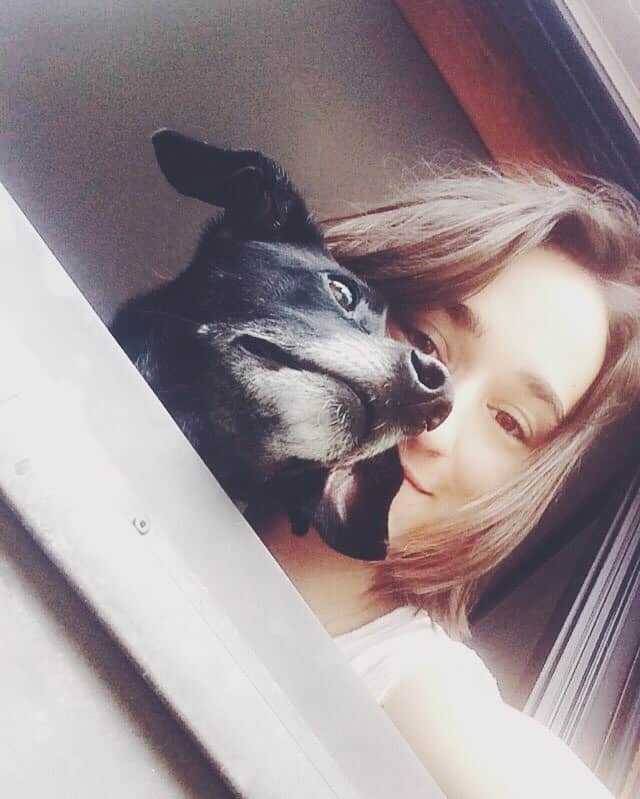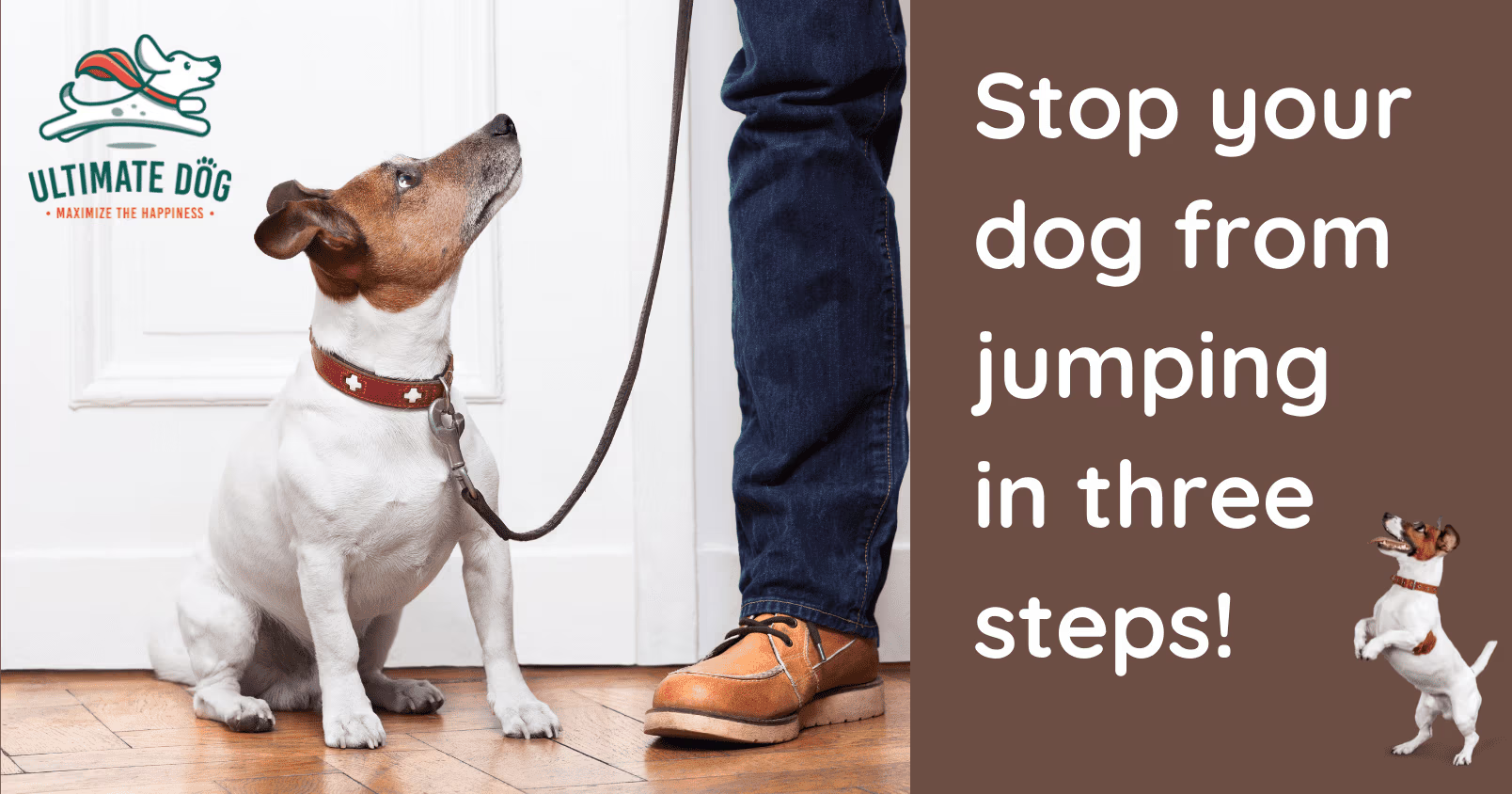Jumping up on people is one of the most common problems faced by dog owners – it is estimated that 90% of dogs jump up on household members at some point in their life and that over 50% of dog owners report jumping as the main problem they are battling with their dog. To effectively address this issue, it is essential to train your dog to stop jumping.
Jumping is also one of the main reasons people surrender their dogs to the animal shelter, citing overexcitability. While fun for dogs, jumping is a big problem for people. It can lead to serious injuries, ripped and muddy clothes, angry guests, and more. Here are three steps to help you solve this problem by using positive reinforcement!
Step 1: Understand why your dog is jumping up
If someone asked you why dogs jump on people, you’d probably answer: “For attention!” Or “Because he’s happy to see you!” This might be true from a human perspective, but dogs are still animals that live primarily on instinct. It is their instincts that regulate their behaviors. Meaning your dog isn’t just jumping on you to seek attention; he is jumping on you because his instincts tell him to do so.
A very interesting study published in 2018 explored the underlying reasons for dogs jumping on people. The researchers looked at this behavior in two different contexts: dogs jumping on owners when they come home and dogs jumping on owners when they hold their food bowl. These two contexts were then split into two additional scenarios – the owners approaching the dogs while standing upright and approaching the dogs while crouching down to their level.
The results showed that dogs were 13 times more likely to jump on their owners when they came home than when they were holding the food bowl. They were also far more likely to jump when the owners were standing upright than when they were crouching down to their level. When the owners crouched down to the dog’s level, the jumping significantly diminished, but the licking of the face increased. The researchers noticed that, in both scenarios, the final destination was the owner’s face – jumping up was just a way to reach it. In other words, if you are not getting down on the dog’s level, the dog will attempt to jump up to yours.
These observations are very significant, and they relate to the instinctual behavior I mentioned earlier. Humans perceive the licking of the face as giving kisses, but the real reason is actually far more primal. Wolf pups and dog pups both lick their mother’s face (more specifically, the corners of her mouth) in an attempt to get food. How does this explain that dogs jumped up more when their owners came through the door and not when they held the bowl?
Dogs are completely dependent on us for survival, and they know it. They understand us as their sole provider of food. In their mind, the owner not returning home could mean starvation. Wolf pups have been observed to mainly beg for food by licking the adult wolves’ mouths when those return from a hunt – and not when they are actually in the presence of the kill. So it’s not that your dog is necessarily hungry when you come home; it’s that he’s instinctually happy to see you because it means his provider is back at the den!
There is another instinctual reason why dogs jump on people, and this one mainly relates to jumping on guests and strangers. While research shows that dogs jump on their owners a lot more than on other people, when they do jump on others, it has to do with the etiquette of greeting.
Dogs are very social beings who are constantly seeking some form of social contact, both with other dogs and with humans. When two dogs meet, they first greet each other face to face and then move to sniff each other’s backsides. That is considered polite canine etiquette. Before the dog is trained to greet humans differently, he’s likely going to say hello in the only way he knows how – face to face.
Now we know why dogs jump up on people – they’re trying to get to our face, either to affirm their bond with us as their sole provider of food or to engage in social contact in the only way they naturally know. There are a few exceptions to this rule (such as jumping for toys or jumping fueled by aggression), but even if your dog doesn’t fit into this general mold, figuring out the reason for jumping is crucial if you want to nip this behavior in the bud.
Step 2: Don’t give your dog the opportunity to practice the unwanted jumping
Behaviors that are practiced are behaviors that persist – especially if they’re getting consistent reinforcement from you, however unintentional. Pushing your dog down, yelling, scolding, and even talking to him gives him exactly what he wants: your full and undivided attention. That is how the jumping gets reinforced. Every time your dog gets the chance to jump on you, the likelihood of this behavior persisting (and getting worse) increases.
Strong boundaries are crucial for positive reinforcement; you cannot do positive training without them. Setting your dog up for success means not giving him the opportunity to constantly make mistakes. Don’t wait until he messes up and then scold him! Instead, think ahead and prevent the jumping before it even has the chance to happen.
The best boundary to use when jumping at home is a barrier, like a puppy (or a baby) gate. The gate should be installed to prevent your dog from reaching you immediately when you step through the door. You can also crate the dog while you’re away, but in this case, the dog needs to be previously crate trained, and your absences shouldn’t be longer than a couple of hours.
If your dog is jumping up on you in another situation (when you’re holding toys, food, or when you’re out on walks), or if he is jumping up on other people when he greets them, use a leash to set the boundary. When your dog is on the leash, you have better control over him. Keep him at a safe distance from other people until he displays the desired behavior (more on that in step 3), or step on the leash, so it’s impossible for him to jump up altogether.
Please note that this step is temporary and crucial for the overall success of the training process. As I mentioned earlier, you’re setting the boundary so that your dog doesn’t have the chance to practice (and further develop) the pattern of jumping. Be consistent with this boundary around all people, even those who say they don’t mind the jumping. Your dog needs to learn that jumping is not okay in any situation!
Step 3: Teach the desired behavior before you ask for it
As soon as you implement boundaries, it’s time to start training the desired behavior that will replace the undesired jumping. You cannot ask for the behavior if you’ve never trained it! First, you need to figure out what you expect from your dog. A lot of people only focus on the behavior they don’t want, but they forget to get clarity on what they do want. What behavior do you want him to display when you step through the front door (or when your dog greets other people)? What do you want him to do?
What works best for me is having my dogs wait on their mat until I come over and say hello to them, but you can also ask your dog to lie down or sit. Once you know what you want, you can start training the desired behavior. Train it in a neutral environment first! This is very important! I recommend doing two short training sessions per day for this specific behavior in an environment that is completely free of distractions. Once your dog gets the hang of it, slowly add more distractions until you are ready to practice this behavior in a situation that mimics real life.
For example: let’s say you want your dog to sit instead of jump. First, you will teach him to sit in a neutral environment without distractions. Then you’ll start adding some distractions – ask your family members to make some noise, clap their hands, drop some toys on the ground, etc. When your dog knows how to sit on cue even when distractions are present, it becomes easier for him to behave well in a high-arousal situation such as your coming home or him greeting new people.
Then, practice the real-life situation! Put on your shoes and coat, leave for just a few minutes, come back home and ask your dog to sit before you pet him. Once he masters this level too, you can begin practicing in the real situation while slowly removing the boundaries you were using before.
I recommend reinforcing the desired behavior with treats first, so that your dog really masters it. Once you level up to practicing the actual coming home or greeting people, you can ditch the treats as the reward is the attention itself. Remember to ASK your dog for the behavior you have trained, especially in the first few months! When you step through the front door, don’t just expect your dog to sit down on his own. It’s important to ask for the behavior! Eventually, he will start to offer this behavior on his own, but not before you’re consistently asking for it.
Quick Recap of the Training Process
This article covers the issue of jumping only through the lens of positive reinforcement; there are other training methods out there, but this is the one I feel comfortable using with my dogs. Positive training is like a puzzle where several things have to work together to achieve success. First, you must understand why the dog is jumping on people and in which situations he is jumping the most. Then you have to implement the appropriate boundaries, so he cannot keep messing up. Use a gate, a crate, or a leash to keep your dog under control during the beginning phases of training.
Once boundaries are implemented, get clear on what you want your dog to do instead of jumping up, then train this behavior in a neutral environment. Gradually raise the level of distractions and make sure to practice the real-life scenarios. Keep reinforcing the correct behavior by giving your dog treats, praise, and attention when he gets it right. If he gets it wrong, be patient and redirect him into the correct position (or back behind the boundary if he’s truly overexcited).
Once you’re confident in his ability to perform the trained behavior in an actual situation, you can drop the boundaries and begin asking for the behavior in your daily life. Make sure you don’t rush this process! Training your dog not to jump will take patience, time, and dedication, but it is all worth it when you’re happy with the result, and the bond between you and your dog is even stronger than it was before!
Sources
Koru, Eva. Havlicek, Zdenek. Rezac, Petr. “Incidence of dogs jumping on household members upon entering their home in comparison with holding food.” Science Direct, 12/2018.
Shabelansky, Anastasia. Dowling-Guyer, Seana. “Characteristics of Excitable Dog Behavior Based on Owners’ Report from a Self-Selected Study.” PMC, 16/03/2016.

Luna’s passion for learning about canine psychology and behavior began when she adopted a severely reactive puppy from a local shelter. She is now a big advocate for positive reinforcement and compassionate training. As a writer, she strives to spotlight the topics that fly under the radar and be the voice for all who cannot speak for themselves.




Leave a Comment